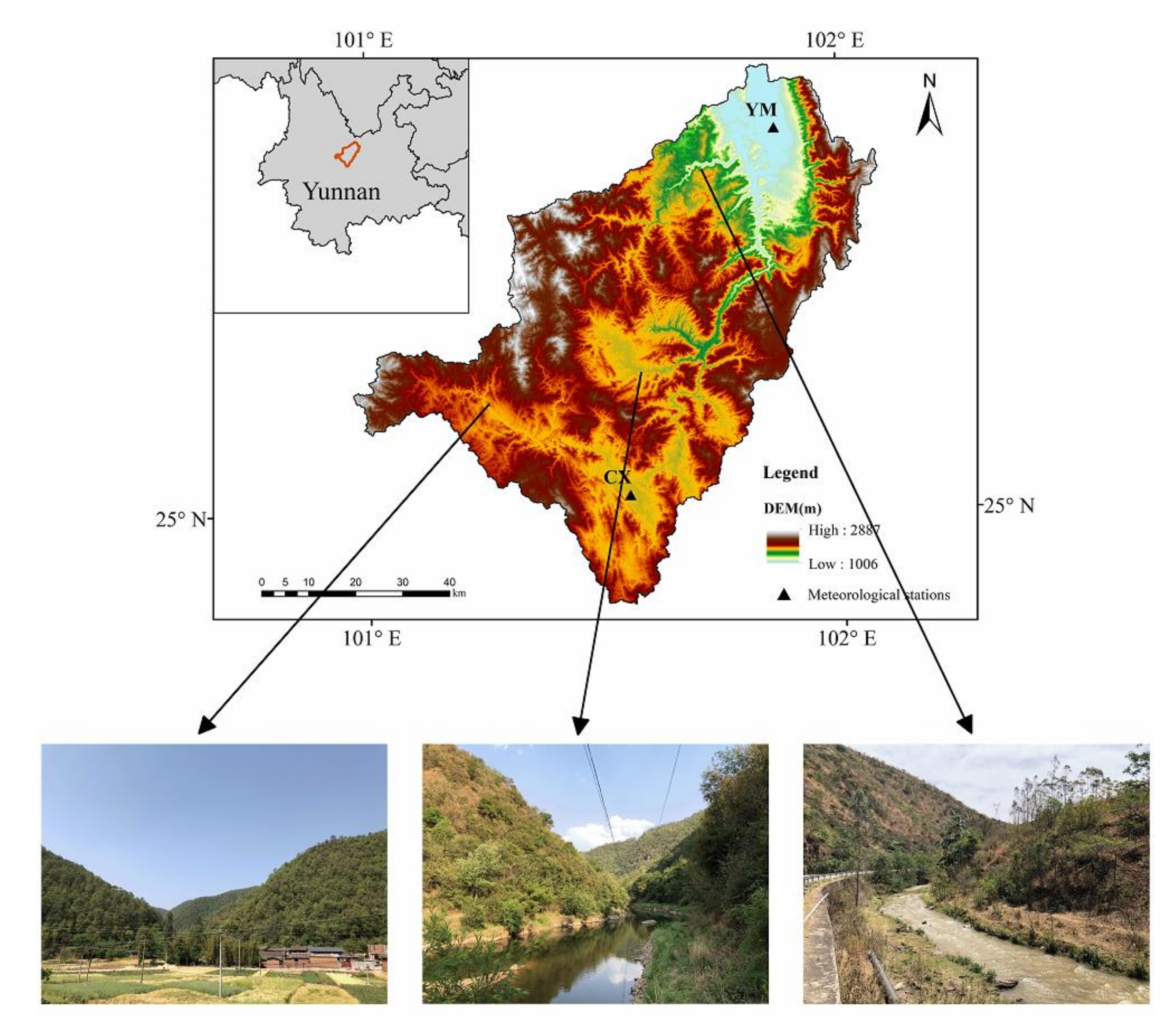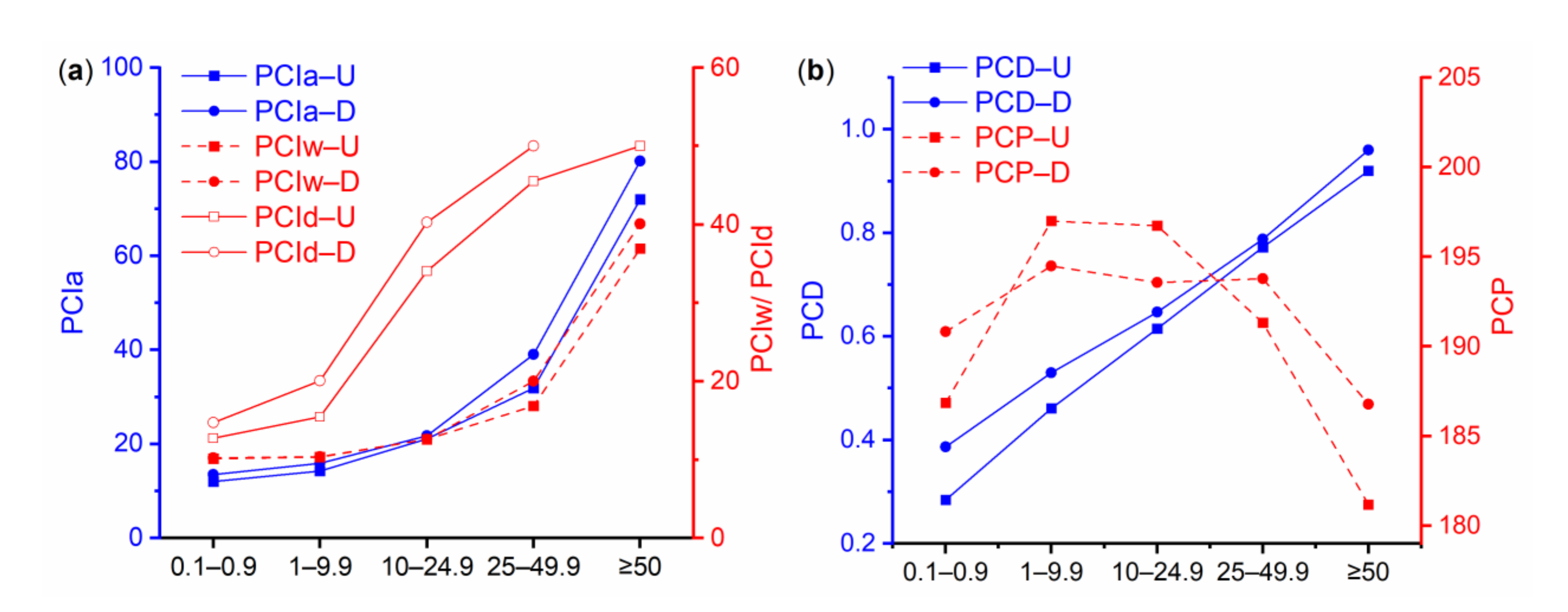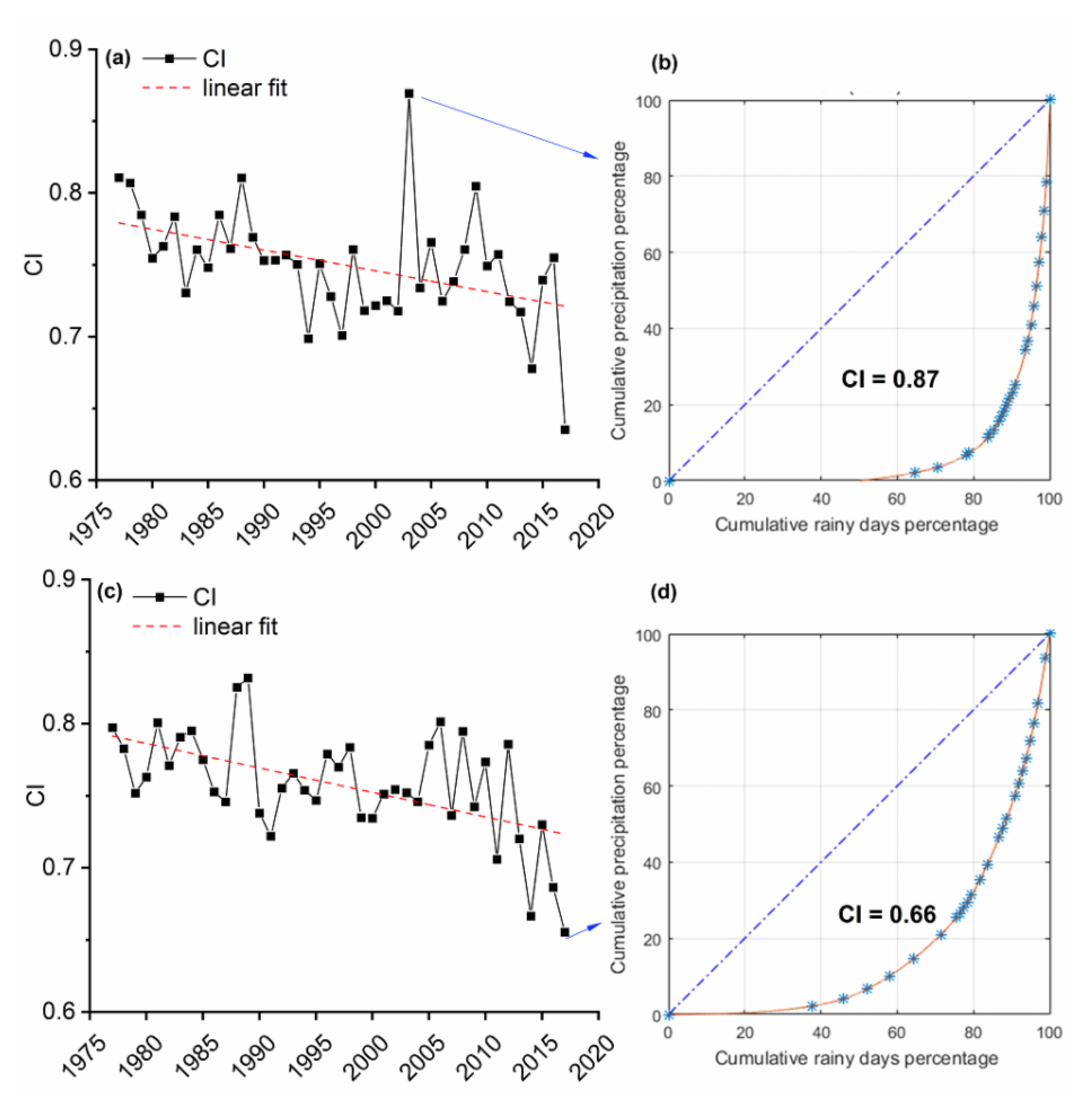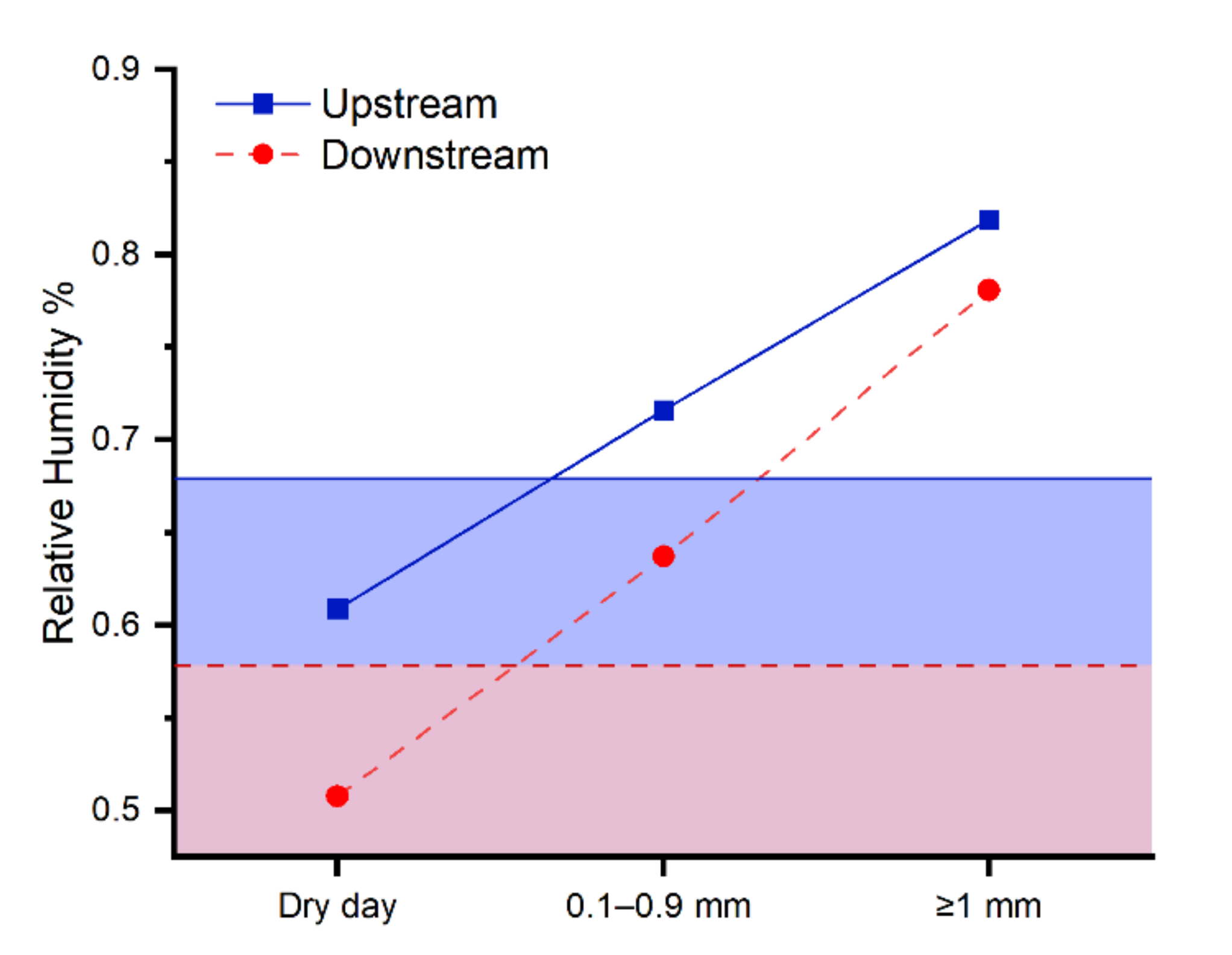Relationship between Precipitation Characteristics at Different Scales and Drought/Flood during the Past 40 Years in Longchuan River, Southwestern China
Abstract
:1. Introduction
2. Materials and Methods
2.1. Study Area
2.2. Data
2.3. Methods
2.3.1. Precipitation Concentration Index (PCI)
2.3.2. Precipitation Concentration Degree (PCD) and Precipitation Concentration Period (PCP)
2.3.3. Gini Concentration Index (CI)
2.3.4. Wet Spells and Dry Spells
2.3.5. Trend Analysis
3. Results
3.1. Annual Precipitation Trends
3.2. Characteristic of Seasonal/Monthly Precipitation
3.3. Characteristic of Daily Precipitation
3.4. Wet Spells and Dry Spells
3.5. Correlation Analysis
4. Discussion
5. Conclusions
Author Contributions
Funding
Institutional Review Board Statement
Informed Consent Statement
Data Availability Statement
Conflicts of Interest
References
- Donat, M.G.; Lowry, A.L.; Alexander, L.V.; O’Gorman, P.A.; Maher, N. More Extreme Precipitation in the World’s Dry and Wet Regions. Nat. Clim. Change 2016, 6, 508–513. [Google Scholar] [CrossRef]
- Rummukainen, M. Climate Change: Changing Means and Changing Extremes. Clim. Change 2013, 121, 3–13. [Google Scholar] [CrossRef]
- Lu, Y.J.; Jiang, S.H.; Ren, L.L.; Zhang, L.Q.; Wang, M.H.; Liu, R.L.; Wei, L.Y. Spatial and Temporal Variability in Precipitation Concentration over Mainland China, 1961–2017. Water 2019, 11, 881. [Google Scholar] [CrossRef] [Green Version]
- Wang, H.J.; Chen, Y.N.; Chen, Z.S. Spatial Distribution and Temporal Trends of Mean Precipitation and Extremes in the Arid Region, Northwest of China, During 1960–2010. Hydrol. Processes 2013, 27, 1807–1818. [Google Scholar] [CrossRef]
- Zhai, P.M.; Zhang, X.B.; Wan, H.; Pan, X.H. Trends in Total Precipitation and Frequency of Daily Precipitation Extremes over China. J. Clim. 2005, 18, 1096–1108. [Google Scholar] [CrossRef]
- Shrestha, S.; Yao, T.D.; Kattel, D.B.; Devkota, L.P. Precipitation Characteristics of Two Complex Mountain River Basins on the Southern Slopes of the Central Himalayas. Theor. Appl. Climatol. 2019, 138, 1159–1178. [Google Scholar] [CrossRef]
- Yang, L.; Villarini, G.; Smith, J.A.; Tian, F.Q.; Hu, H.P. Changes in Seasonal Maximum Daily Precipitation in China over the Period 1961–2006. Int. J. Climatol. 2013, 33, 1646–1657. [Google Scholar] [CrossRef]
- Chatterjee, S.; Khan, A.; Akbari, H.; Wang, Y.P. Monotonic Trends in Spatio-Temporal Distribution and Concentration of Monsoon Precipitation (1901–2002), West Bengal, India. Atmos. Res. 2016, 182, 54–75. [Google Scholar] [CrossRef]
- Huang, Y.; Wang, H.; Xiao, W.H.; Chen, L.H.; Yang, H. Spatiotemporal Characteristics of Precipitation Concentration and the Possible Links of Precipitation to Monsoons in China from 1960 to 2015. Theor. Appl. Climatol. 2019, 138, 135–152. [Google Scholar] [CrossRef]
- Jiang, P.; Wang, D.G.; Cao, Y.Q. Spatiotemporal Characteristics of Precipitation Concentration and Their Possible Links to Urban Extent in China. Theor. Appl. Climatol. 2016, 123, 757–768. [Google Scholar] [CrossRef]
- Zhang, L.-N.; Zhang, Y.-B.; Wang, J.-D. Effects of Annual Distribution Difference of Precipitation on Evapotranspiration Characteristics of Dry Orchard in Loess Plateau, China. J. Appl. Ecol. 2020, 31, 2363–2372. [Google Scholar] [CrossRef]
- Guo, E.L.; Wang, Y.F.; Jirigala, B.; Jin, E. Spatiotemporal Variations of Precipitation Concentration and Their Potential Links to Drought in Mainland China. J. Clean. Prod. 2020, 267, 14. [Google Scholar] [CrossRef]
- Du, J.; Fang, J.; Xu, W.; Shi, P. Analysis of Dry/Wet Conditions Using the Standardized Precipitation Index and Its Potential Usefulness for Drought/Flood Monitoring in Hunan Province, China. Stoch. Environ. Res. Risk Assess. 2013, 27, 377–387. [Google Scholar] [CrossRef]
- Kosmas, C.; Tsara, M.; Moustakas, N.; Karavitis, C. Identification of Indicators for Desertification. Ann. Arid. Zone 2003, 42, 393–416. [Google Scholar]
- Nunes, A.N.; Lourenco, L.; Vieira, A.; Bento-Goncalves, A. Precipitation and Erosivity in Southern Portugal: Seasonal Variability and Trends (1950–2008). Land Degrad. Dev. 2016, 27, 211–222. [Google Scholar] [CrossRef]
- Apollonio, C.; Petroselli, A.; Tauro, F.; Cecconi, M.; Biscarini, C.; Zarotti, C.; Grimaldi, S. Hillslope Erosion Mitigation: An Experimental Proof of a Nature-Based Solution. Sustainability 2021, 13, 6058. [Google Scholar] [CrossRef]
- Martin-Vide, J. Spatial Distribution of a Daily Precipitation Concentration Index in Peninsular Spain. Int. J. Climatol. 2004, 24, 959–971. [Google Scholar] [CrossRef]
- Wang, W.G.; Xing, W.Q.; Yang, T.; Shao, Q.X.; Peng, S.Z.; Yu, Z.B.; Yong, B. Characterizing the Changing Behaviours of Precipitation Concentration in the Yangtze River Basin, China. Hydrol. Processes 2013, 27, 3375–3393. [Google Scholar] [CrossRef]
- Monjo, R.; Martin-Vide, J. Daily Precipitation Concentration around the World According to Several Indices. Int. J. Climatol. 2016, 36, 3828–3838. [Google Scholar] [CrossRef]
- Hu, S.S.; Feng, F.; Liu, W.B.; She, D.X. Changes in Temporal Inequality and Persistence of Precipitation over China During the Period 1961–2013. Hydrol. Res. 2018, 49, 1283–1291. [Google Scholar] [CrossRef] [Green Version]
- Oliver, J.E. Monthly Precipitation Distribution—A Comparative Index. Prof. Geogr. 1980, 32, 300–309. [Google Scholar] [CrossRef]
- Ramezani, Y.; Khashei-Siuki, A.; Tahroudi, M.N. Spatial Distribution of the Daily, Monthly, and Annual Precipitation Concentration Indices in the Lake Urmia Basin, Iran. Idojaras 2020, 124, 73–95. [Google Scholar] [CrossRef]
- Khalili, K.; Tahoudi, M.N.; Mirabbasi, R.; Ahmadi, F. Investigation of Spatial and Temporal Variability of Precipitation in Iran over the Last Half Century. Stoch. Environ. Res. Risk Assess. 2016, 30, 1205–1221. [Google Scholar] [CrossRef]
- Zhang, L.J.; Qian, Y.F. Annual Distribution Features of Precipitation in China and Their Interannual Variations. Acta Meteorol. Sin. 2003, 17, 146–163. [Google Scholar]
- Ratan, R.; Venugopal, V. Wet and Dry Spell Characteristics of Global Tropical Rainfall. Water Resour. Res. 2013, 49, 3830–3841. [Google Scholar] [CrossRef]
- Mathugama, S.; Peiris, T. Critical Evaluation of Dry Spell Research. Int. J. Basic Appl. Sci. 2011, 11, 153–160. [Google Scholar]
- Liu, Y.L.; Yan, J.P.; Cen, M.Y. The Relationship between Precipitation Heterogeneity and Meteorological Drought/Flood in China. J. Meteorol. Res. 2016, 30, 758–770. [Google Scholar] [CrossRef]
- Zhang, L.J.; Qian, Y.F. A Study on the Feature of Precipitation Concentration and Its Relation to Flood-Producing in the Yangtze River Valley of China. Chin. J. Geophys. 2004, 47, 709–718. [Google Scholar] [CrossRef]
- Chen, Y.; Zhai, P.M. Changing Structure of Wet Periods across Southwest China During 1961–2012. Clim. Res. 2014, 61, 123–131. [Google Scholar] [CrossRef]
- Qin, J.; Ding, Y.J.; Zhao, Q.D.; Wang, S.P.; Chang, Y.P. Assessments on Surface Water Resources and Their Vulnerability and Adaptability in China. Adv. Clim. Change Res. 2020, 11, 381–391. [Google Scholar] [CrossRef]
- Xu, K.; Yang, D.W.; Yang, H.B.; Li, Z.; Qin, Y.; Shen, Y. Spatio-Temporal Variation of Drought in China During 1961–2012: A Climatic Perspective. J. Hydrol. 2015, 526, 253–264. [Google Scholar] [CrossRef]
- Official Chuxiong Yi Autonomous Prefecture. Chuxiong Prefecture Yearbook; People’s Government of Chuxiong Yi Autonomous Prefecture; Yunnan Publishing Group Co.: Kunming, China, 2016; p. 216. [Google Scholar]
- Official Chuxiong Yi Autonomous Prefecture. Chuxiong Prefecture Yearbook; People’s Government of Chuxiong Yi Autonomous Prefecture: Kunming, China, 2000. [Google Scholar]
- Zhang, J.P.; Yang, Z.; Wang, D.J.; Zhang, X.B. Climate Change and Causes in the Yuanmou Dry-Hot Valley of Yunnan, China. J. Arid. Environ. 2002, 51, 153–162. [Google Scholar] [CrossRef]
- Xiao, Z.N.; Zhou, X.H.; Yang, P.; Liu, H. Variation and Future Trends in Precipitation over Summer and Autumn across the Yunnan Region. Front. Earth Sci. 2016, 10, 498–512. [Google Scholar] [CrossRef]
- De Luis, M.; Gonzalez-Hidalgo, J.C.; Brunetti, M.; Longares, L.A. Precipitation Concentration Changes in Spain 1946–2005. Nat. Hazards Earth Syst. Sci. 2011, 11, 1259–1265. [Google Scholar] [CrossRef] [Green Version]
- Li, X.M.; Jiang, F.Q.; Li, L.H.; Wang, G.Q. Spatial and Temporal Variability of Precipitation Concentration Index, Concentration Degree and Concentration Period in Xinjiang, China. Int. J. Climatol. 2011, 31, 1679–1693. [Google Scholar] [CrossRef]
- Masaki, Y.; Hanasaki, N.; Takahashi, K.; Hijioka, Y. Global-Scale Analysis on Future Changes in Flow Regimes Using Gini and Lorenz Asymmetry Coefficients. Water Resour. Res. 2014, 50, 4054–4078. [Google Scholar] [CrossRef]
- Damgaard, C.; Weiner, J. Describing Inequality in Plant Size or Fecundity. Ecology 2000, 81, 1139–1142. [Google Scholar] [CrossRef]
- Li, Z.; Li, Y.P.; Shi, X.P.; Li, J.J. The Characteristics of Wet and Dry Spells for the Diverse Climate in China. Glob. Planet. Change 2017, 149, 14–19. [Google Scholar] [CrossRef]
- Mann, H.B. Nonparametric Tests against Trend. Econometrica 1945, 13, 245–259. [Google Scholar] [CrossRef]
- Kendall, M.G. Rank Correlation Methods. Br. J. Psychol. Gen. 1990, 11–12, 86–91. [Google Scholar] [CrossRef]
- Shi, W.L.; Yu, X.Z.; Liao, W.G.; Wang, Y.; Jia, B.Z. Spatial and Temporal Variability of Daily Precipitation Concentration in the Lancang River Basin, China. J. Hydrol. 2013, 495, 197–207. [Google Scholar] [CrossRef]
- Rahman, A.-U.; Dawood, M. Spatio-Statistical Analysis of Temperature Fluctuation Using Mann-Kendall and Sen’s Slope Approach. Clim. Dyn. 2017, 48, 783–797. [Google Scholar] [CrossRef]
- Douglas, E.M.; Vogel, R.M.; Kroll, C.N. Trends in Floods and Low Flows in the United States: Impact of Spatial Correlation. J. Hydrol. 2000, 240, 90–105. [Google Scholar] [CrossRef]
- Sen, P.K. Estimates of the Regression Coefficient Based on Kendall’s Tau. J. Am. Stat. Assoc. 1968, 63, 1379–1389. [Google Scholar] [CrossRef]
- Li, Y.G.; He, D.M.; Hu, J.M.; Cao, J. Variability of Extreme Precipitation over Yunnan Province, China 1960–2012. Int. J. Climatol. 2015, 35, 245–258. [Google Scholar] [CrossRef]
- Li, Y.G.; Wang, Z.X.; Zhang, Y.Y.; Li, X.; Huang, W. Drought Variability at Various Timescales over Yunnan Province, China: 1961–2015. Theor. Appl. Climatol. 2019, 138, 743–757. [Google Scholar] [CrossRef]
- Sang, Y.F.; Wang, Z.G.; Li, Z.L.; Liu, C.M.; Liu, X.J. Investigation into the Daily Precipitation Variability in the Yangtze River Delta, China. Hydrol. Processes 2013, 27, 175–185. [Google Scholar] [CrossRef]
- Huang, G.; Wen, G. Spatial and Temporal Variations of Light Rain Events over China and the Mid-High Latitudes of the Northern Hemisphere. Chin. Sci. Bull. 2013, 58, 1402–1411. [Google Scholar] [CrossRef] [Green Version]
- Wen, G.H.; Huang, G.; Hu, K.M.; Qu, X.; Tao, W.C.; Gong, H.N. Changes in the Characteristics of Precipitation over Northern Eurasia. Theor. Appl. Climatol. 2015, 119, 653–665. [Google Scholar] [CrossRef]
- Choi, Y.S.; Ho, C.H.; Kim, J.; Gong, D.Y.; Park, R.J. The Impact of Aerosols on the Summer Rainfall Frequency in China. J. Appl. Meteorol. Climatol. 2008, 47, 1802–1813. [Google Scholar] [CrossRef] [Green Version]
- Qian, Y.; Gong, D.Y.; Fan, J.W.; Leung, L.R.; Bennartz, R.; Chen, D.L.; Wang, W.G. Heavy Pollution Suppresses Light Rain in China: Observations and Modeling. J. Geophys. Res.-Atmos. 2009, 114, 16. [Google Scholar] [CrossRef]
- Xiang, K.Y.; Li, Y.; Horton, R.; Feng, H. Similarity and Difference of Potential Evapotranspiration and Reference Crop Evapotranspiration—A Review. Agric. Water Manag. 2020, 232, 16. [Google Scholar] [CrossRef]
- Jiang, C.; Mu, X.; Ma, W.; Yu, X.; Liu, X.; Li, J.; Liu, S.; Wang, F. Spatial and Temporal Variation of Absolute Humidity and Its Relationship with Potential Evaporation in the Northern and Southern Regions of Qinling Mountains. Acta Ecol. Sin. 2015, 35, 378–388. [Google Scholar]
- Chen, H.; Yang, G.; Lin, M.; Wu, J.; Yuan, F. Spatiotemporal Changes and Affecting Factors of Potential Evapotranspiration in the Second Songhua River Basin. Res. Soil Water Conserv. 2021, 28, 238. [Google Scholar]
- Kang, S.Z.; Zhang, L.; Song, X.Y.; Zhang, S.H.; Liu, X.Z.; Liang, Y.L.; Zheng, S.Q. Runoff and Sediment Loss Responses to Rainfall and Land Use in Two Agricultural Catchments on the Loess Plateau of China. Hydrol. Processes 2001, 15, 977–988. [Google Scholar] [CrossRef]
- Nearing, M.A.; Jetten, V.; Baffaut, C.; Cerdan, O.; Couturier, A.; Hernandez, M.; Le Bissonnais, Y.; Nichols, M.H.; Nunes, J.P.; Renschler, C.S.; et al. Modeling Response of Soil Erosion and Runoff to Changes in Precipitation and Cover. Catena 2005, 61, 131–154. [Google Scholar] [CrossRef]
- Nearing, M.A.; Pruski, F.F.; O’Neal, M.R. Expected Climate Change Impacts on Soil Erosion Rates: A Review. J. Soil Water Conserv. 2004, 59, 43–50. [Google Scholar]
- Zhang, K.X.; Yao, Y.L.; Qian, X.Q.; Wang, J.J. Various Characteristics of Precipitation Concentration Index and Its Cause Analysis in China between 1960 and 2016. Int. J. Climatol. 2019, 39, 4648–4658. [Google Scholar] [CrossRef]
- Bai, A.; Liu, X. Characteristics of Rainfall Variation over East China During the Last 50 Years and Their Relationships with Droughts and Floods. J. Trop. Meteorol. 2010, 26, 194–200. [Google Scholar]







| Indices | Definitions | Units |
|---|---|---|
| SDII | annual total precipitation divided by the number of total wet days (≥0.1 mm) in the year | mm/d |
| NDS | annual number of the dry spells | event |
| NWS | annual number of the wet spells | event |
| ADS | annual average length of dry spells | days |
| AWS | annual average length of wet spells | days |
| MDS | largest number of consecutive days of dry spell (<0.1 mm) | days |
| MWS | largest number of consecutive days of wet spell (≥0.1 mm) | days |
| DS95 | total days when the length of dry spell > 95th percentile of the dry days in the 1981–2010 period | days |
| WS95 | total days when the length of wet spell > 95th percentile of the wet days in the 1981–2010 period | days |
| MPW | the maximum amount of precipitation during a wet spell | mm |
| Rx1day | the maximum precipitation amount on 1 day | mm |
| Rx5day | the maximum precipitation amount on consecutive 5 days | mm |
| R95p | total precipitation amount when the daily precipitation > 95th percentile of precipitation on wet days in the 1981–2010 period | mm |
| Precipitation | Rainy days | SDII | ||||
|---|---|---|---|---|---|---|
| Intensity | Amount | Proportion | Amount | Proportion | Amount | |
| (mm/10 a) | (%/10 a) | (d/10 a) | (%/10 a) | ((mm/d)/10 a) | ||
| Upstream | Total | 20.16 | N | −15.00 *** | N | 0.57 *** |
| SP 0.1–0.9 | −2.68 *** | −0.39 *** | −13.13 *** | −4.03 *** | +0 | |
| LP 1–9.9 | −5.11 | −1.35 | −2.31 ** | 1.76 ** | 0.06 | |
| MP 10–24.9 | 6.02 | 0.12 | 0.30 | 1.25 *** | 0.25 | |
| HP 25–49.9 | 8.94 | 0.86 | +0 | 1.88 *** | 0.33 | |
| EP ≥ 50 mm | −0 | +0 | −0 | 0.02 | 2.63 | |
| Downstream | Total | −5.08 | N | −9.65 *** | N | 0.34 *** |
| SP 0.1–0.9 | −0.65 * | −0.10 | −7.78 *** | −2.42 *** | 0.02 *** | |
| LP 1–9.9 | −4.84 | −0.40 | −2.00 ** | 0.66 | 0.06 | |
| MP 10–24.9 | 0.79 | 0.31 | +0 | 0.95 *** | 0.11 | |
| HP 25–49.9 | 3.19 | 0.73 | +0 | 0.33 * | 0.07 | |
| EP ≥ 50 mm | −1.87 | −0.60 | −0 | −0 | −1.20 | |
| Intensity | Precipitation | Rainy Days | SDII | |||
|---|---|---|---|---|---|---|
| Amount | Proportion | Amount | Proportion | Amount | ||
| (mm/10 a) | (%/10 a) | (d/10 a) | (%/10 a) | ((mm/d)/10 a) | ||
| Upstream | Total | 14.99 | −0.45 | −6.17 *** | 2.77 *** | 0.43 *** |
| SP 0.1–0.9 | −1.14 *** | −0.17 *** | −4.44 *** | −0.12 | −0 | |
| LP 1–9.9 | −3.15 | −0.90 | −1.46 | 1.47 * | 0.07 | |
| MP 10–24.9 | 7.15 | 0.06 | +0 | 0.99 *** | 0.25 | |
| HP 25–49.9 | 6.00 | 0.07 | +0 | 0.41 * | 0.50 | |
| EP ≥ 50 mm | −0 | +0 | −0 | +0 | 2.26 | |
| Downstream | Total | −8.61 | −0.67 | −6.23 *** | 0.43 | 0.36 *** |
| SP 0.1–0.9 | −0.30 | −0.04 | −4.41 *** | −0.86 | 0.02 *** | |
| LP 1–9.9 | −5.30 | −0.58 | −2.03 ** | 0.39 | 0.09 | |
| MP 10–24.9 | −2.65 | −0.12 | −0 | 0.75 ** | 0.21 | |
| HP 25–49.9 | 2.22 | 0.54 | +0 | 0.32 | 0.02 | |
| EP ≥ 50 mm | −1.87 | −0.60 | −0 | −0 | −1.20 | |
| Season | Intensity | Precipitation | Rainy Days | SDII | ||
|---|---|---|---|---|---|---|
| Amount | Proportion | Amount | Proportion | Amount | ||
| (mm/10 a) | (%/10 a) | (d/10 a) | (%/10 a) | ((mm/d)/10 a) | ||
| Upstream | Total | 5.28 | 0.45 | −8.91 *** | −2.77 *** | 0.42 *** |
| SP 0.1–0.9 | −1.40 *** | −0.18 *** | −8.30 *** | −3.60 *** | 0.01 | |
| LP 1–9.9 | −1.38 | −0.42 | −0.69 | 0.29 | 0.04 | |
| MP 10–24.9 | +0 | +0 | +0 | 0.13 | −0.37 | |
| HP 25–49.9 | +0 | 0.01* | +0 | +0 | −1.50 | |
| EP ≥ 50 mm | - | - | - | - | - | |
| Downstream | Total | 4.40 | 0.67 | −3.03 *** | −0.43 | 0.31 ** |
| SP 0.1–0.9 | −0.36 * | −0.06 | −3.33 *** | −1.22 *** | 0.01 | |
| LP 1–9.9 | 1.49 | 0.22 | −0 | 0.46 | 0.20 | |
| MP 10–24.9 | +0 | +0 | +0 | 0.11 | −0.94 | |
| HP 25–49.9 | - | - | - | - | - | |
| EP ≥ 50 mm | - | - | - | - | - | |
| Intensity | PCIa (/10 a) | PCIw (/10 a) | PCId (/10 a) | PCD (/10 a) | PCP (°/10 a) | |
|---|---|---|---|---|---|---|
| Upstream | Total | 0.144 | 0.206 | 1.287 ** | −0.001 | −1.442 |
| SP 0.1–0.9 | 0.613 *** | 0.209 | 0.757 *** | 0.017 | 3.550 | |
| LP 1–9.9 | 0.092 | −0.087 | 0.379 | 0.008 | −4.000 * | |
| MP 10–24.9 | 0.115 | 0.181 | +0 | −0.019 | −3.703 | |
| HP 25–49.9 | 1.176 | 0.942 * | −0 | −0.006 | −0.046 | |
| EP ≥ 50 mm | −0 | −0 | - | −0 | 0.218 | |
| Downstream | Total | −0.006 | 0.152 | 1.475 | −0.018 | −1.333 |
| SP 0.1–0.9 | 0.443 * | 0.269 * | 0.010 | 0.014 | 3.610 | |
| LP 1–9.9 | −0.157 | 0.175 | −0.137 | −0.006 | −4.601 * | |
| MP 10–24.9 | −0.096 | 0.136 | −0 | −0.024 | −6.287 ** | |
| HP 25–49.9 | 2.224 | 1.253 | - | −0.015 | 3.162 | |
| EP ≥ 50 mm | −0 | −0 | N | −0 | 0.250 |
| NDS (Event/10 a) | ADS (d/10 a) | MDS (d/10 a) | DS95 (d/10 a) | |
|---|---|---|---|---|
| Upstream | −1.82 *** | 0.49 *** | 3.14 *** | 19.00 *** |
| Downstream | +0 | 0.25 * | 2.50 * | 14.10 *** |
| NWS | AWS | MWS | WS95 | MPW | R × 1 Day | R × 5 Day | R95p | |
|---|---|---|---|---|---|---|---|---|
| (Event/10 a) | (d/10 a) | (d/10 a) | (d/10 a) | (mm/10 a) | (mm/10 a) | (mm/10 a) | (mm/10 a) | |
| Upstream | −1.85 ** | −0.17 *** | −1.43 ** | −13.33 *** | −2.72 | 0.04 | 2.93 | 19.98 |
| Downstream | −0 | −0.22 *** | −1.34 *** | −9.52 *** | −6.84 ** | −2.72 | −2.56 | −3.03 |
Publisher’s Note: MDPI stays neutral with regard to jurisdictional claims in published maps and institutional affiliations. |
© 2022 by the authors. Licensee MDPI, Basel, Switzerland. This article is an open access article distributed under the terms and conditions of the Creative Commons Attribution (CC BY) license (https://creativecommons.org/licenses/by/4.0/).
Share and Cite
Liu, Y.; Yan, D.; Wen, A.; Shi, Z.; Chen, T.; Chen, R. Relationship between Precipitation Characteristics at Different Scales and Drought/Flood during the Past 40 Years in Longchuan River, Southwestern China. Agriculture 2022, 12, 89. https://doi.org/10.3390/agriculture12010089
Liu Y, Yan D, Wen A, Shi Z, Chen T, Chen R. Relationship between Precipitation Characteristics at Different Scales and Drought/Flood during the Past 40 Years in Longchuan River, Southwestern China. Agriculture. 2022; 12(1):89. https://doi.org/10.3390/agriculture12010089
Chicago/Turabian StyleLiu, Yuan, Dongchun Yan, Anbang Wen, Zhonglin Shi, Taili Chen, and Ruiyin Chen. 2022. "Relationship between Precipitation Characteristics at Different Scales and Drought/Flood during the Past 40 Years in Longchuan River, Southwestern China" Agriculture 12, no. 1: 89. https://doi.org/10.3390/agriculture12010089





